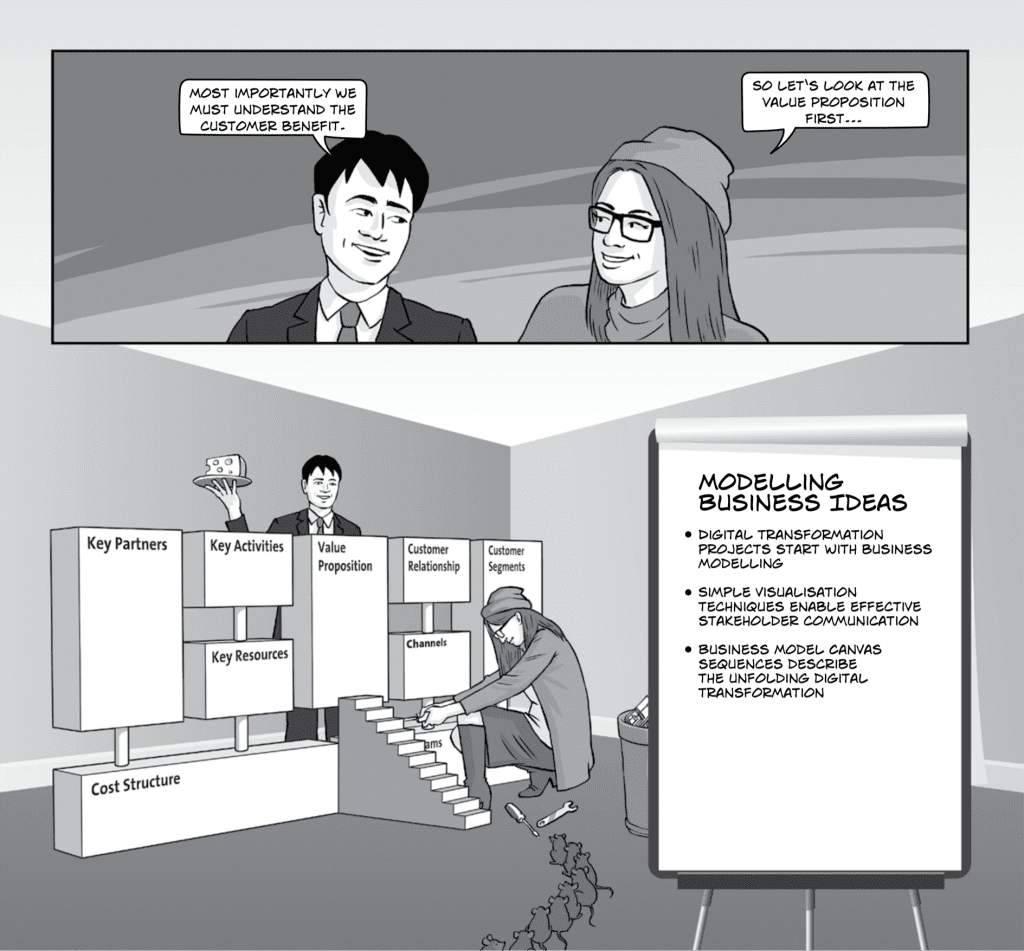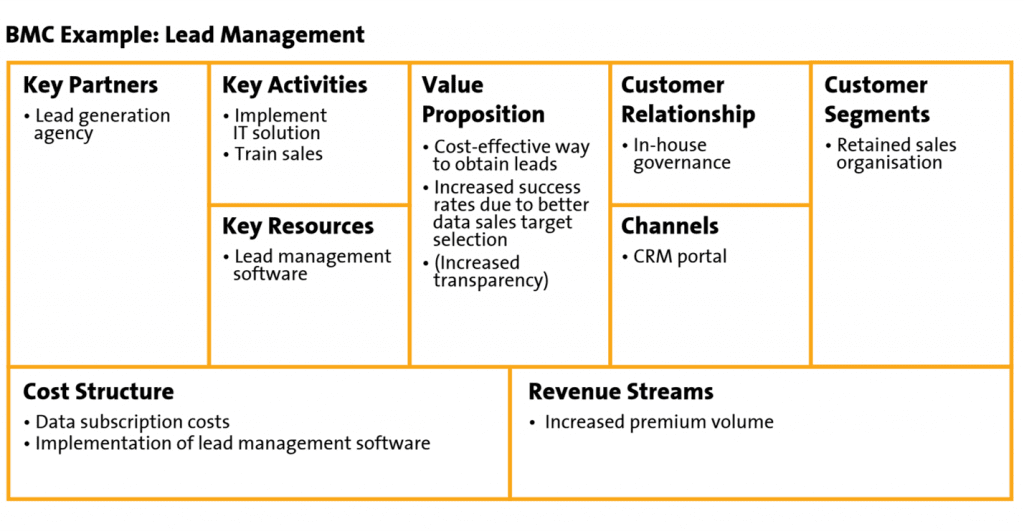In this section, we deal with the specification of business models and business purpose. As opposed to traditional projects that usually begin their work with an in-depth analysis of user requirements and processes, we suggest starting at a higher level. Interestingly, traditional projects also benefit from a precise outlining of business models and purpose, which are both subsequently agreed upon with all stakeholders. However, in a digitalisation programme it is essential to start with a high-level assessment. Due to the speed of digitalisation, the comprehensiveness of the change and the rather blurry level of detail of business requirements at the outset, the members of an implementation project must be given a delimitation within which they can autonomously conduct the project, and – at the same time – contribute to the digital transformation process and the prosperity of the entire enterprise.
As described in the previous section, a method is needed to iteratively develop business models. This starts at the highest level with the business model of the complete enterprise. As the business model undergoes transformation during digitalisation, individual projects contribute to this comprehensive change. At the start of the transformation, it is important to gain an overview of potential projects as well as their interdependencies and the synergy potential between them. Further iterations will deepen the understanding of the individual projects.
A suitable technique here is Osterwalder’s Business Model Canvas (BMC) [1] or the St. Galler Management-Modell.[2]
The BMC, which we will focus on here, allows an easy visualisation and step-by-step clarification of an otherwise rather ‘cloudy’ subject of discussion — the elements of a business model.
The method is based on the concept of subdividing a business model into nine core building blocks — customer (segments), value proposition, channels, customer relations, revenues, resources, activities, partners and costs.[3]
The BMC approach helps to lay out the business model systematically and in a structurally sound manner, and enables the valuation of new ideas as well as their differentiation from the status quo.
The BMC points out competitive advantages as well as customer benefits and hence helps to estimate a new business idea’s potential success.
The following chart depicts an example of a high-level BMC at project level. This small chart already shows comprehensively the focus of the topic ‘Lead Management’, who the customer is, etc. In subsequent iterations, the BMC will be improved by adding descriptions of how precisely the value proposition will be implemented and delivered to the customer.
A project-level BMC must be related to one or more BMCs at the enterprise level. For example, assuming that the main business model of the corporation is selling insurance policies (hence increasing the volume and value of premiums might be a major objective), the project described in the canvas contributes to this purpose (see chart below).
An important aspect is that all specifications are located on one single canvas page. Doing this substantially simplifies the practical comparison of the different business ideas and business model variations. A second advantage is the possibility of deploying the method using both real or virtual whiteboards and flip charts and thus enhancing the exchange of ideas within and between teams.
A BMC should not be seen as a traditional project deliverable, created and used within a project’s predefined time period.
Creating and maintaining BMCs is instead a continuous process that should be conducted or at least supported by an enterprise-level team. The responsibility for generating BMCs is typically handed over to a team of functional architects and business analysts. In a project situation, the BMC is typically used to conduct interviews or workshops with different stakeholders. An advantage of the BMC methodology is that one can quickly create a first draft of a specification in a compact time period of only 60 to 90 minutes; the specification can then be readily improved and detailed further. With the support of the BMC, it is possible to visualise dependencies in very high-level discussions and to collect and compare different points of view on critical topics. The BMC approach also helps to outline the development of a business model over a longer period – e.g., modelling a sequence of BMCs helps business stakeholders to understand what results can be expected at different points of a transformation roadmap.
At this point, the iterative character of the BMC approach should be highlighted once again. In this way, the application of the BMC methodology corresponds to the notion of an agile approach and can significantly help to achieve agreement on a ‘Start-Set-Up’ for the business model discussions. The scope of implementation is already well-defined by the BMC and the ‘Start-Set-Up’ can be used as a basis for further, more detailed specifications.
_____
[1] Osterwalder, A., Pigneur, Y.: ‘Business Model Generation: A Handbook for Visionaries, Game Changers, and Challengers’, John Wiley & Sons, 2010.
[2] Rüegg-Stürm, J.: ‘Das neue St. Galler Management-Modell. Grundkategorien einer intergrierten Managementlehre: HSG-Ansatz’, 2nd ed., Haupt Verlag, p. 22, 2003.
[3] Osterwalder, Pigneur: p. 15ff.





